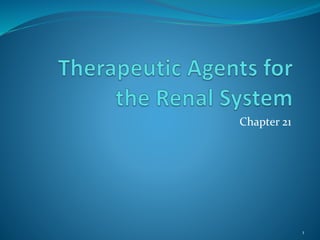This document provides information about the renal and urological systems and conditions that affect them. It describes the anatomy and functions of the kidneys, nephrons, bladder and urethra. Conditions discussed include chronic kidney disease, kidney stones, edema, urinary tract infections, and urinary incontinence. Drug treatments are outlined for these conditions, including diuretics, antibiotics, analgesics, and supplements. Non-drug therapies like dialysis and lifestyle changes are also mentioned.














![Tubular Secretion (Cont.)
Hydrogen ions combine to form bicarbonate
They are released into bloodstream to regulate overall
pH of body, maintaining homeostasis
Bicarbonate molecules act as a buffer because they can
either bind hydrogen ions [creating a basic environment
by decreasing the hydrogen ion concentration] or
release hydrogen ions [creating an acidic environment
by increasing the hydrogen ion concentration]).
15](https://image.slidesharecdn.com/renalsystem-160407175421/85/Renal-system-15-320.jpg)



















